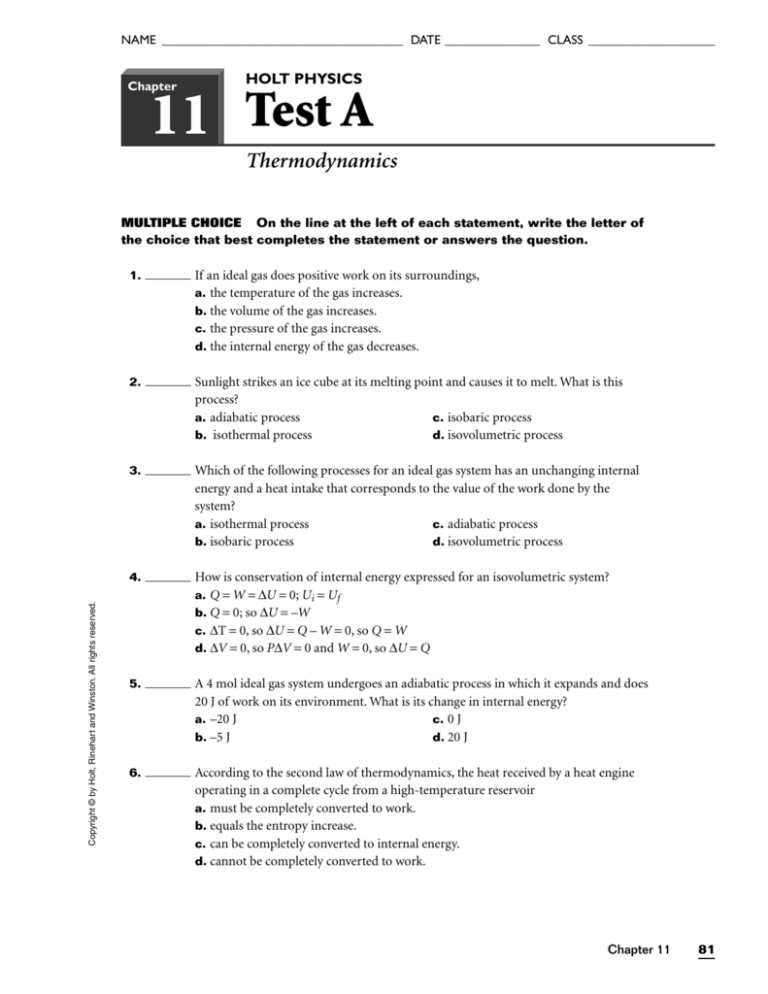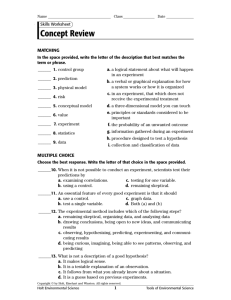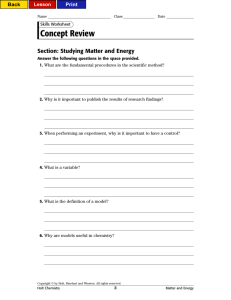
NAME ______________________________________ DATE _______________ CLASS ____________________
Chapter
HOLT PHYSICS
11 Test A
Thermodynamics
Copyright © by Holt, Rinehart and Winston. All rights reserved.
MULTIPLE CHOICE On the line at the left of each statement, write the letter of
the choice that best completes the statement or answers the question.
1.
If an ideal gas does positive work on its surroundings,
a. the temperature of the gas increases.
b. the volume of the gas increases.
c. the pressure of the gas increases.
d. the internal energy of the gas decreases.
2.
Sunlight strikes an ice cube at its melting point and causes it to melt. What is this
process?
a. adiabatic process
c. isobaric process
b. isothermal process
d. isovolumetric process
3.
Which of the following processes for an ideal gas system has an unchanging internal
energy and a heat intake that corresponds to the value of the work done by the
system?
a. isothermal process
c. adiabatic process
b. isobaric process
d. isovolumetric process
4.
How is conservation of internal energy expressed for an isovolumetric system?
a. Q = W = ∆U = 0; Ui = Uf
b. Q = 0; so ∆U = –W
c. ∆T = 0, so ∆U = Q – W = 0, so Q = W
d. ∆V = 0, so P∆V = 0 and W = 0, so ∆U = Q
5.
A 4 mol ideal gas system undergoes an adiabatic process in which it expands and does
20 J of work on its environment. What is its change in internal energy?
a. –20 J
c. 0 J
b. –5 J
d. 20 J
6.
According to the second law of thermodynamics, the heat received by a heat engine
operating in a complete cycle from a high-temperature reservoir
a. must be completely converted to work.
b. equals the entropy increase.
c. can be completely converted to internal energy.
d. cannot be completely converted to work.
Chapter 11
81
NAME ______________________________________ DATE _______________ CLASS ____________________
11
HOLT PHYSICS
continued
Test A
7.
When a system’s disorder is increased,
a. less energy is available to do work.
b. more energy is available do work.
c. no energy is available to do work.
d. no work is done.
8.
According to the second law of thermodynamics, which of the following applies for
any process that can occur within an isolated system?
a. Entropy remains constant.
b. Entropy increases.
c. Entropy decreases.
d. Entropy equals work done.
9.
When an egg is broken and scrambled, the entropy of the system
a. increases, and the total entropy of the universe increases.
b. decreases, and the total entropy of the universe increases.
c. increases, and the total entropy of the universe decreases.
d. decreases, and the total entropy of the universe decreases.
10.
An ideal gas is maintained at a constant pressure of 7.0 × 104 N/m2 during an isobaric
process while its volume decreases by 0.20 m3. What work is done by the system on its
environment?
a. 1.4 × 104 J
c. −1.4 × 104 J
b. 3.5 × 105 J
d. −3.5 × 104 J
11.
A cylinder has a cross-sectional area of 0.02 m2. How much work is done by a gas in
the cylinder if the gas exerts a constant pressure of 7.8 × 105 Pa on the piston, moving
it a distance of 0.06 m?
a. 6.5 × 102 J
c. 6.5 × 108 J
b. 9.4 × 102 J
d. 9.4 × 108 J
12.
Over several cycles, a refrigerator does 5.13 × 104 J of work on the refrigerant. The
refrigerant, in turn, removes 9.63 × 104 J as heat from the air inside the refrigerator.
What is the net change in the internal energy of the refrigerant?
a. 0.00 J
c. 6.38 × 104 J
4
b. 4.92 × 10 J
d. 9.84 × 104 J
13.
An engine absorbs 2150 J as heat from a hot reservoir and gives off 750 J as heat to a
cold reservoir during each cycle. How much work is done during each cycle?
a. 750 J
c. 2150 J
b. 1400 J
d. 2900 J
82
Holt Physics Chapter Tests
Copyright © by Holt, Rinehart and Winston. All rights reserved.
Chapter
NAME ______________________________________ DATE _______________ CLASS ____________________
Chapter
11
HOLT PHYSICS
continued
Test A
14.
A steam engine takes in 2.06 × 105 J of energy added as heat and exhausts 1.53 × 105 J
of energy removed as heat per cycle. What is its efficiency?
a. 0.743
c. 0.257
b. 0.346
d. 0.673
15.
An engine adds 75 000 J of energy as heat and removes 15 000 J of energy as heat.
What is the engine’s efficiency?
a. 0.80
c. 0.50
b. 0.20
d. 0.60
SHORT ANSWER
provided.
Write the answers to the following questions in the space
16. A physics textbook is balanced on top of an inflated balloon on a cold morning. As the day
passes, the temperature increases, the balloon expands, and the textbook rises. Is there a
transfer of energy as heat? If so, what is it? Has any work been done?
Copyright © by Holt, Rinehart and Winston. All rights reserved.
17. A system consists of a bomb that explodes. Is energy being transferred as heat to the system, or
is work being done on the system?
18. How is the conservation of the internal energy of an isolated system expressed?
Chapter 11
83
NAME ______________________________________ DATE _______________ CLASS ____________________
Chapter
11
HOLT PHYSICS
continued
Test A
19. State the second law of thermodynamics.
20. How does using a screwdriver to insert a screw into a wood table increase entropy and reduce
Copyright © by Holt, Rinehart and Winston. All rights reserved.
the ability of energy to do work?
84
Holt Physics Chapter Tests
NAME ______________________________________ DATE _______________ CLASS ____________________
Chapter
HOLT PHYSICS
11 Test B
Thermodynamics
Copyright © by Holt, Rinehart and Winston. All rights reserved.
MULTIPLE CHOICE On the line at the left of each statement, write the letter of
the choice that best completes the statement or answers the question.
1.
A 2 mol ideal gas system is maintained at a constant volume of 4 L. If the pressure is
constant, how much work is done by the system?
a. 0 J
c. 8 J
b. 5 J
d. 30 J
2.
Air cools as it escapes from a diver’s compressed air tank. What kind of process is this?
a. isothermal
c. adiabatic
b. isobaric
d. isovolumetric
3.
Which of the following is a thermodynamic process that takes place at a constant
temperature and in which the internal energy of a system remains unchanged?
a. adiabatic process
c. isovolumetric process
b. isothermal process
d. isobaric process
4.
How is conservation of internal energy expressed for an adiabatic system?
a. Q = W = ∆U = 0; Ui = Uf
b. Q = 0, so ∆U = –W
c. ∆T = 0, so ∆U = Q – W = 0, so Q = W
d. ∆V = 0, so P∆V = 0 and W = 0, so ∆U = Q
5.
How is conservation of internal energy expressed for an isolated system?
a. Q = W = ∆U = 0; Ui = Uf
b. Q = 0; so ∆U = –W
c. ∆T = 0, so ∆U = Q – W = 0, so Q = W
d. ∆V = 0, so P∆V = 0 and W = 0, so ∆U = Q
6.
A 4 mol ideal gas system undergoes an adiabatic process in which it expands and does
20 J of work on its environment. What is its change in internal energy?
a. −20 J
c. 0 J
b. −5 J
d. 20 J
7.
The requirement that a heat engine must give up some energy at a lower temperature
in order to do work corresponds to which law of thermodynamics?
a. first
b. second
c. third
d. No law of thermodynamics applies.
Chapter 11
85
NAME ______________________________________ DATE _______________ CLASS ____________________
Chapter
11
9.
Test B
A ball is thrown against a brick wall. After the collision,
a. the kinetic energy increases, and the ball is capable of doing more work.
b. the kinetic energy decreases, and the ball is capable of doing less work.
c. the kinetic energy increases, and the ball is capable of doing less work.
d. the kinetic energy decreases, and the ball is capable of doing more work.
Imagine you could observe the individual atoms that make up a piece of matter and
that you observe the motion of the atoms becoming more orderly. What can you
assume about the system?
a. Its entropy is increasing.
b. Its entropy is decreasing.
c. It is gaining thermal energy.
d. Positive work is being done on the system.
10.
When a drop of ink mixes with water, the entropy of the system
a. increases, and the total entropy of the universe increases.
b. decreases, and the total entropy of the universe increases.
c. increases, and the total entropy of the universe decreases.
d. decreases, and the total entropy of the universe decreases.
11.
A container of gas is at a pressure of 1.3 × 105 Pa and a volume of 6.0 m3. How much
work is done by the gas if it expands at constant pressure to twice its initial volume?
a. 3.7 × 105 J
c. 7.8 × 105 J
b. 2.6 × 105 J
d. 4.6 × 105 J
12.
A cylinder has a cross-sectional area of 0.02 m2. How much work is done by a gas in
the cylinder if the gas exerts a constant pressure of 7.8 × 105 Pa on the piston, moving
it a distance of 0.06 m?
a. 6.5 × 102 J
c. 6.5 × 108 J
b. 9.4 × 102 J
d. 9.4 × 108 J
13.
Over several cycles, a refrigerator does 1.73 × 104 J of work on the refrigerant. The
refrigerant, in turn, removes 8.11 × 104 J as heat from the air inside the refrigerator.
How much work is done on the air inside the refrigerator?
a. 0.00 J
c. –8.11 × 104 J
4
b. 1.73 × 10 J
d. 9.84 × 104 J
14.
An engine absorbs 2150 J as heat from a hot reservoir and gives off 750 J as heat to a
cold reservoir during each cycle. How much work is done during each cycle?
a. 750 J
c. 2150 J
b. 1400 J
d. 2900 J
86
Holt Physics Chapter Tests
Copyright © by Holt, Rinehart and Winston. All rights reserved.
8.
HOLT PHYSICS
continued
NAME ______________________________________ DATE _______________ CLASS ____________________
Chapter
11
HOLT PHYSICS
continued
Test B
15.
An electrical power plant manages to transfer 88 percent of the heat produced in the
burning of fossil fuel to convert water to steam. Of the heat carried by the steam, 40
percent is converted to the mechanical energy of the spinning turbine. Which best
describes the overall efficiency of the heat-to-work conversion in the plant?
a. greater than 88 percent
c. less than 40 percent
b. 64 percent
d. 40 percent
16.
A turbine exhausts 69 400 J of energy added as heat when it puts out
21 300 J of net work. What is the efficiency of the turbine?
a. 3.26
c. 0.693
b. 0.307
d. 0.235
SHORT ANSWER
provided.
Write the answers to the following questions in the space
17. A mechanic pushes down very quickly on the plunger of an insulated pump. The air hose is
Copyright © by Holt, Rinehart and Winston. All rights reserved.
plugged so that no air escapes. Describe any transfer of energy as heat and any work done on or
by the air in the system.
18. A match is struck on a matchbook cover to create a flame. Is energy being transferred as heat to
the system, or is work being done on the system?
19. How does Qc > 0 relate to the second law of thermodynamics?
Chapter 11
87
NAME ______________________________________ DATE _______________ CLASS ____________________
Chapter
11
HOLT PHYSICS
continued
Test B
20. How does using a screwdriver to insert a screw into a wood table increase entropy and reduce
Copyright © by Holt, Rinehart and Winston. All rights reserved.
the ability of energy to do work?
88
Holt Physics Chapter Tests
Chapter 11 Test Form A
Chapter 11 Test Form B
1. B
2. B
3. A
4. D
5. A
6. D
7. A
8. B
9. A
10. C
11. B
12. A
13. B
14. C
15. A
16. Energy from the air was transferred into the bal-
1. A
2. C
3. B
4. B
5. A
6. A
7. B
8. B
9. B
10. A
11. C
12. B
13. C
14. B
15. C
16. D
17. No energy is transferred into or out of the sys-
tem. Work is done on the air in the system.
18. Work is being done on the system.
19. Some energy must always be transferred as heat
to the system’s surroundings.
20. Instead of doing work on the screw, some of the
energy goes toward increasing the internal energy of the screw and wood.
Copyright © by Holt, Rinehart and Winston. All rights reserved.
loon as heat. The balloon did work on the book.
17. Energy is being transferred as heat to the system.
18. It can be expressed as Q = W = 0 and as ∆U
= Q – W = 0.
19. No machine can be made that only absorbs energy as heat and then entirely transfers the energy out of the engine as an equal amount of
work.
20. Instead of doing work on the screw, some of the
energy goes toward increasing the internal energy of the screw and wood.
Answer Key
211








